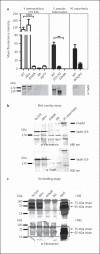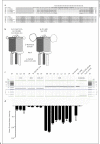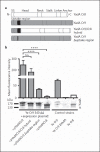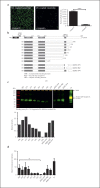Vitronectin Binds to a Specific Stretch within the Head Region of Yersinia Adhesin A and Thereby Modulates Yersinia enterocolitica Host Interaction
- PMID: 27798934
- PMCID: PMC6738804
- DOI: 10.1159/000449200
Vitronectin Binds to a Specific Stretch within the Head Region of Yersinia Adhesin A and Thereby Modulates Yersinia enterocolitica Host Interaction
Abstract
Complement resistance is an important virulence trait of Yersinia enterocolitica (Ye). The predominant virulence factor expressed by Ye is Yersinia adhesin A (YadA), which enables bacterial attachment to host cells and extracellular matrix and additionally allows the acquisition of soluble serum factors. The serum glycoprotein vitronectin (Vn) acts as an inhibitory regulator of the terminal complement complex by inhibiting the lytic pore formation. Here, we show YadA-mediated direct interaction of Ye with Vn and investigated the role of this Vn binding during mouse infection in vivo. Using different Yersinia strains, we identified a short stretch in the YadA head domain of Ye O:9 E40, similar to the 'uptake region' of Y. pseudotuberculosis YPIII YadA, as crucial for efficient Vn binding. Using recombinant fragments of Vn, we found the C-terminal part of Vn, including heparin-binding domain 3, to be responsible for binding to YadA. Moreover, we found that Vn bound to the bacterial surface is still functionally active and thus inhibits C5b-9 formation. In a mouse infection model, we demonstrate that Vn reduces complement-mediated killing of Ye O:9 E40 and, thus, improved bacterial survival. Taken together, these findings show that YadA-mediated Vn binding influences Ye pathogenesis.
© 2016 S. Karger AG, Basel.
Figures







Similar articles
-
Yersinia adhesin A (YadA)--beauty & beast.Int J Med Microbiol. 2015 Feb;305(2):252-8. doi: 10.1016/j.ijmm.2014.12.008. Epub 2014 Dec 24. Int J Med Microbiol. 2015. PMID: 25604505 Review.
-
Contribution of trimeric autotransporter C-terminal domains of oligomeric coiled-coil adhesin (Oca) family members YadA, UspA1, EibA, and Hia to translocation of the YadA passenger domain and virulence of Yersinia enterocolitica.J Bacteriol. 2008 Jul;190(14):5031-43. doi: 10.1128/JB.00161-08. Epub 2008 May 16. J Bacteriol. 2008. PMID: 18487327 Free PMC article.
-
Role of β1 integrins and bacterial adhesins for Yop injection into leukocytes in Yersinia enterocolitica systemic mouse infection.Int J Med Microbiol. 2016 Feb;306(2):77-88. doi: 10.1016/j.ijmm.2015.12.001. Epub 2015 Dec 15. Int J Med Microbiol. 2016. PMID: 26718660
-
Trimer stability of YadA is critical for virulence of Yersinia enterocolitica.Infect Immun. 2010 Jun;78(6):2677-90. doi: 10.1128/IAI.01350-09. Epub 2010 Mar 22. Infect Immun. 2010. PMID: 20308293 Free PMC article.
-
YadA, the multifaceted Yersinia adhesin.Int J Med Microbiol. 2001 Aug;291(3):209-18. doi: 10.1078/1438-4221-00119. Int J Med Microbiol. 2001. PMID: 11554561 Review.
Cited by
-
Identifying components required for OMP biogenesis as novel targets for antiinfective drugs.Virulence. 2017 Oct 3;8(7):1170-1188. doi: 10.1080/21505594.2016.1278333. Epub 2017 Jan 24. Virulence. 2017. PMID: 28118090 Free PMC article.
-
Adhesion preference of the sticky bacterium Acinetobacter sp. Tol 5.Front Bioeng Biotechnol. 2024 Feb 5;12:1342418. doi: 10.3389/fbioe.2024.1342418. eCollection 2024. Front Bioeng Biotechnol. 2024. PMID: 38375452 Free PMC article.
-
SurA-like and Skp-like Proteins as Important Virulence Determinants of the Gram Negative Bacterial Pathogens.Int J Mol Sci. 2022 Dec 24;24(1):295. doi: 10.3390/ijms24010295. Int J Mol Sci. 2022. PMID: 36613738 Free PMC article. Review.
-
Immunogenicity of trimeric autotransporter adhesins and their potential as vaccine targets.Med Microbiol Immunol. 2020 Jun;209(3):243-263. doi: 10.1007/s00430-019-00649-y. Epub 2019 Dec 1. Med Microbiol Immunol. 2020. PMID: 31788746 Free PMC article. Review.
-
Yersinia enterocolitica in Crohn's disease.Front Cell Infect Microbiol. 2023 Mar 8;13:1129996. doi: 10.3389/fcimb.2023.1129996. eCollection 2023. Front Cell Infect Microbiol. 2023. PMID: 36968108 Free PMC article. Review.
References
-
- Bottone EJ. Yersinia enterocolitica: overview and epidemiologic correlates. Microbes Infect. 1999;1:323–333. - PubMed
-
- Cover TL, Aber RC. Yersinia enterocolitica. N Engl J Med. 1989;321:16–24. - PubMed
-
- Isberg RR. Mammalian cell adhesion functions and cellular penetration of enteropathogenic Yersinia species. Mol Microbiol. 1989;3:1449–1453. - PubMed
MeSH terms
Substances
LinkOut - more resources
Full Text Sources
Other Literature Sources
Molecular Biology Databases

